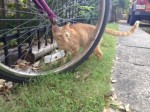A few months ago we noticed one of our cats was losing an alarming amount of fur. It was clear to us by the pattern of the hair loss that she was grooming excessively in some areas – literally licking the hair off of some parts of her body, entirely. She’s such a sweet, quiet cat that we were embarrassed to have to admit to our vet that we barely noticed this was happening.
Our regular vet is a pretty practical guy and after looking for some of what we thought might be the likely suspects in our cat’s discomforting hair loss- allergy, parasites, dry skin- he turned his questions to us and asked how much psychological stimulation our cat was getting at home. Really? Psychological stimulation at home? Isn’t that automatic, like digestion? It turns out, the answer is ” No.” It’s not automatic, and his prescription was an injection of an anti-inflammatory steroid (DepoMedrol), and instructions to basically go home and play and interact with your cat (a lot), and watch what happens.
Unlike feral and free range cats who can exercise their natural needs to hunt & explore in a large territory, indoor cats can often succumb to boredom, and can manifest that boredom by excessive licking/grooming, aggression, being destructive in the home, and over eating. It turns out we just weren’t offering enough satisfying opportunities in the home for our cat to act naturally.
Once we got home our strategy was threefold: First, BUY A LOT OF CAT TOYS!! Toys with feathers, balls with lights, stuffed animals, and, we actually made a few ourselves, just to be crafty – which turned out to be the most popular toys, anyway. Who do you think thinks this stuff up anyway? I doubt there are actual cat toy engineers – so go ahead and make some yourself, and start having fun.
But, it’s not enough to simply drop a bunch of cat toys on the floor and hope that does the trick for your cat. Thus, part 2 of our strategy was to set aside 3 play periods every day, where we would interact exclusively with our two cats (just like our dog gets his exclusive walk times) – once in the morning, after work, and before bedtime. We interacted mostly by playing, but also petting and brushing- anything that kept them engaged with us for a steady period of time.
 Thirdly, both cats had at least 3 periods each day where they could spend time outside on our screened back porch. Being out there is the next best thing to free range- birds, insects, falling leaves, even other community cats passing through our yard- together provide some pretty dense, natural stimulation, and a relief from quiet and boredom.The results were immediate and we saw that not only did the excessive grooming fall away, but there were increases in agility, balance, eye tracking – all those things you’d expect from a normal, healthy cat looking to catch it’s next meal. Even if it does come from a can.
Thirdly, both cats had at least 3 periods each day where they could spend time outside on our screened back porch. Being out there is the next best thing to free range- birds, insects, falling leaves, even other community cats passing through our yard- together provide some pretty dense, natural stimulation, and a relief from quiet and boredom.The results were immediate and we saw that not only did the excessive grooming fall away, but there were increases in agility, balance, eye tracking – all those things you’d expect from a normal, healthy cat looking to catch it’s next meal. Even if it does come from a can.
Cat Teaser Toy
You’ll Need:
1. Wood dowel rods, up to 1/4 inch diameter
2. Spool of ribbon
3. Duct Tape….Yes!
4. Scissors
Cut 5 to 6 strands of ribbon, each about 12 inches long. With the duct tape, tape the ribbon ends to a dowel rod – any length will do. To keep the ribbons on longer, especially if you have a super energetic cat, take the cap off a ball point pen and feed the ribbon through the openings, then press the cap onto the dowel end.
Written by Brian Knight, Pet Sitter at Sarah’s Pet Care Revolution






